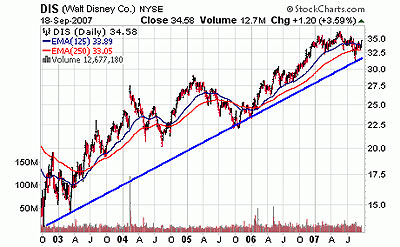The Decline of Disney
Published on July 30th, 2009 in: Cartoons, DVD, Issues, Movies, Over the Gadfly's Nest, Retrovirus |By Maureen
They don’t make ’em like they used to: the nature of Walt Disney productions has changed. In the mid-1990s, the success of Toy Story brought the new (and previously untapped) market of computer animation into the picture. Disney’s computer-animated films have become very popular, and there are some quality movies affiliated with Disney. Recently, both WALL-E and Up have received critical and financial success. As Disney has begun to adapt their technology and marketing to the computer age, the overall tenor of their animated films has monopolized the genre.

Image from StockCharts.com
Personally, I find Disney’s computer-animated films visually stunning and usually quite entertaining. They are not, however, anything like the Disney films I enjoyed while I was in elementary school (and would still enjoy if they didn’t get squirreled away into the “Disney vault” and unavailable for sale on DVD). Classics like Aladdin and Beauty and the Beast (still the only animated feature to be nominated for a Best Picture Oscar) were filled with catchy songs and lovable characters. Today’s films still have lovable characters, but the departure from musical numbers, and the increasing reliance on mainstream celebrity voice talent has changed the nature of the films as a whole. These changes have not gone unnoticed by parents, critics, and fans alike.
WALL-E and Up have both received some negative press for having themes that can be considered too dark and/or depressing for the intended young audiences to grasp. This is not a new complaint, however; many film fans still regard the death of Bambi’s mother to be one of the most upsetting and disturbing scenes to ever appear in a children’s movie. Parents may now have to consider the content or “message” of the films carefully before taking their children of a certain age, a heretofore unknown concept when dealing with Disney movies. Similarly, children and younger pre-teens seem to have more enthusiasm over Disney the channel than Disney the movie studio. While I don’t think it would be entirely fair to say that the newer films are necessarily worse than their hand-drawn predecessors, the change in both the content and the reaction of younger audiences to them has certainly started some noteworthy snowball effects.
In the wake of this new generation of animated films, I’ve noticed an interesting situation: Disney has partnered with Pixar Animation studios for all of its recent films. The dazzling visuals and the departure from the classic Disney musical format, means these films are often recognized as Pixar first and Disney second. This has given Disney time to focus on other endeavors and this is where the problems enter the picture.
The Disney Channel can be a great source of entertainment for younger audiences, where parents don’t have to worry about sex and violence and foul language. Lately, however, The Disney Channel seems to have shoved movies out of the way to become the company’s main source of both revenue and marketing. It has become a factory for fabricated “tween” stars, and Disney seizes any instance to remind us of that. Even worse, the mainstream media has played into it, so now anyone hoping to get across Sixth Avenue at seven a.m. for his or her morning commute has to fend off crying twelve-year-olds waiting for the Jonas Brothers to close the Good Morning America concert series.
Disney has become its own pint-sized version of cable reality television, with spin-offs and tie-ins, and crossovers. Every one on every show has an album, which when released, is purchased in record numbers by children too young to have any conceivable access to extra money. The inevitable success of these albums is then parlayed into a tour, which sells out in similar record numbers and time periods. Some of this footage is shot by a camera crews, and is immediately edited into a version that’s subsequently released in theaters. The madness then begins anew with a different group—or as in the case of one incredibly popular young woman, a different “alter ego”—featuring the same exact musical style and limited vocal range.
When I was in college I used to pop into the Disney Store when I was in the local mall, to see if there were any cute stuffed animals or collectible toys I might want for a young relative (or myself). The last time I went into the store, I barely recognized anything. The majority of the store was Hannah Montana, The Suite Life of Zack and Cody, and Jonas Brothers merchandise. Shirts, albums, lunchboxes, and all other forms of paraphernalia that I can’t recall filled the shelves, pushing the beloved figures of my childhood to the back.
Who are these usurping kids, and what makes them worthy of being the figureheads of Disney? Will their oeuvre be treated with the same reverence as the Disney films of years past? Until anyone can come up with satisfactory answers to these questions, I will just enjoy Pixar films, hoping that the Disney vault opens back up soon.
One Response to “The Decline of Disney”
July 30th, 2009 at 11:20 pm
[…] See the rest here: The Decline of Disney […]
Time limit is exhausted. Please reload the CAPTCHA.